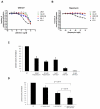Dual mTORC2/mTORC1 targeting results in potent suppressive effects on acute myeloid leukemia (AML) progenitors
- PMID: 21415215
- PMCID: PMC3131493
- DOI: 10.1158/1078-0432.CCR-10-2285
Dual mTORC2/mTORC1 targeting results in potent suppressive effects on acute myeloid leukemia (AML) progenitors
Abstract
Purpose: To determine whether mTORC2 and rapamycin-insensitive (RI)-mTORC1 complexes are present in acute myeloid leukemia (AML) cells and to examine the effects of dual mTORC2/mTORC1 inhibition on primitive AML leukemic progenitors.
Experimental design: Combinations of different experimental approaches were used, including immunoblotting to detect phosphorylated/activated forms of elements of the mTOR pathway in leukemic cell lines and primary AML blasts; cell-proliferation assays; direct assessment of mRNA translation in polysomal fractions of leukemic cells; and clonogenic assays in methylcellulose to evaluate leukemic progenitor-colony formation.
Results: mTORC2 complexes are active in AML cells and play critical roles in leukemogenesis. RI-mTORC1 complexes are also formed and regulate the activity of the translational repressor 4E-BP1 in AML cells. OSI-027 blocks mTORC1 and mTORC2 activities and suppresses mRNA translation of cyclin D1 and other genes that mediate proliferative responses in AML cells. Moreover, OSI-027 acts as a potent suppressor of primitive leukemic precursors from AML patients and is much more effective than rapamycin in eliciting antileukemic effects in vitro.
Conclusions: Dual targeting of mTORC2 and mTORC1 results in potent suppressive effects on primitive leukemic progenitors from AML patients. Inhibition of the mTOR catalytic site with OSI-027 results in suppression of both mTORC2 and RI-mTORC1 complexes and elicits much more potent antileukemic responses than selective mTORC1 targeting with rapamycin.
Figures






References
-
- Lowenberg B, Downing JR, Burnett A. Acute myeloid leukemia. N Engl J Med. 1999;341:1051–62. - PubMed
-
- Tallman MS, Gilliland DG, Rowe JM. Drug therapy for acute myeloid leukemia. Blood. 2005;106:1154–63. - PubMed
-
- Gilliland DG, Tallman MS. Focus on acute leukemias. Cancer Cell. 2002;1:417–20. - PubMed
-
- Cammenga J. Gatekeeper pathways and cellular background in the pathogenesis and therapy of AML. Leukemia. 2005;19:1719–28. - PubMed
Publication types
MeSH terms
Substances
Grants and funding
LinkOut - more resources
Full Text Sources
Medical
Research Materials
Miscellaneous

